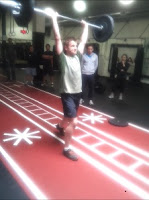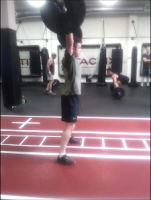Stepping Up to the Olympic Weightlifting Bar
Last Updated on October 10, 2015 by Alfred Ball
 |
| Split Clean and Jerk – 42.22 kg |
Stepping up to the bar is about completing challenges that push your limits with grit, determination and enthusiasm. This weekend I had an opportunity to learn how to teach and properly complete the two Olympic lifts – the Snatch and the Clean and Jerk. It is surprising as an athlete who competed at a national level that these were not skills I learned as part of my strength and conditioning in Biathlon. They are very good at building total body power, resiliency and motor co-ordination. Olympic weightlifting can be taught with dowels or PVC pipes to youth and even the elderly.
The two day course was held at Tactix Gym in Vancouver and taught by members of the BC Weightlifting Association. It is the technical component of the first level of coaching for the sport in Canada. We had excellent coaches who challenged our own abilities, but who were also able to assist us in correcting our technique.
These technical lifts that are not meant to be “muscled” through. Until this weekend I was slightly intimated by them because I wasn’t confident in my own upper-body strength or power. The sports I participate in arepredominantly leg and endurance. I strongly believe that Olympic lifts can be applied to all individuals when taught in a progressive manner and with modifications when needed. They do apply movements of daily activities, work and recreation. For example, the clean and jerk mimics the action lifting a bag into the overhead compartment in an airplane.
 |
| Snatch 24.4 kg 07-21-2012 |
There are many myths about the sport including that Olympic Weightlifters are slow and not flexible. Olympic Weightlifting is a sport with one of the lowest rates of injuries.
It is a power sport, meaning that you need to lift as much weight as possible as over a specific distance with finesses and explosiveness, while remaining under control. Shoulder and hip mobility are needed to finish the lift as well as start the lift.
I lost count of the number of times I lifted 24.4kg or more, but we kept repeating 3-5 reps of each lift and progressions with small breaks in between as our coaches came around to give us tips of what to work on.
Both Mike and Brock paid close attention to me to encourage me to keep going and to push my own physical and mental limits include the ability to generate a lot of power. To be a successful endurance athlete you need to produce power, but over a long period of time, a component I am developing.
The second day was a review of the Snatch and the Clean and Jerk with various teaching progressions. We also were able to coach each other in a group format. Olympic Weightlifting athletes don’t just train the lifts, they also work on assistant exercises like the back squat, front squat and good morning. These additional exercises help ingrain the appropriate motor patterns while also building strength in areas where the athlete is weaker.
At the end of the day we split into pairs for a three lift competition. My partner was Coach Brock; I chose the Clean and Jerk. The goal was to attempt three consecutive lifts with incremental weight changes. With the confidence of my coach I was able to Clean and Jerk 42.22kg. This surprised me and gave me great joy.
At the end of the weekend I left with a renewed confidence in my own abilities, a few things to work on and a few coaching tips and knowing that a good quality lifiting bar will save your shoulders because it spins properly. I have a few videos of my lifts so that I can review them later to compare with future training sessions. The Olympic lifts also use the central nervous system heavily so, let’s just say Sunday night I slept very well.
Additional Resources
The Benefits of Olympic Weightlifting.
The BC Weightlifting Association
To book an Olympic lifting session with Alfred in North Vancouver call 604.283.1858 ext 1.






